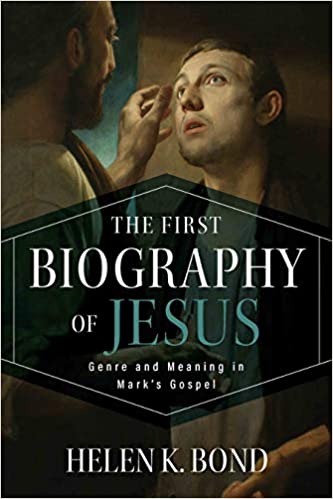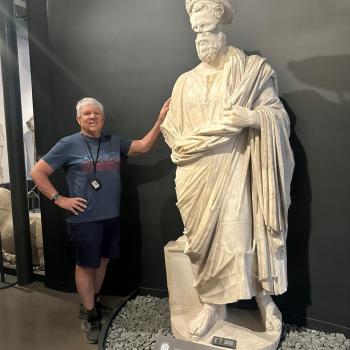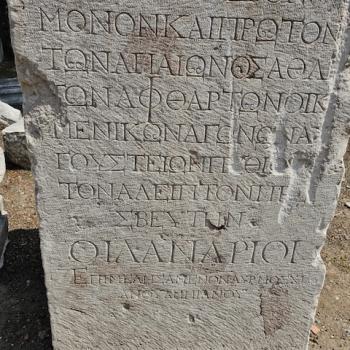BEN: While I am quite dubious in regard to claims of large chiastic structures in Mark, not least because that is a ‘visual’ device, one that has to be seen by a reader of a text, and Mark’s Gospel is largely meant to be heard by the majority audience, I think you have a good point about the use of synkrisis in Mark. This makes good rhetorical sense of various passages. What do you see as the main thing Mark is trying to accomplish using this device?
HELEN:
Actually my book started off as a study of synkrisis within the passion narrative, but then expanded in directions I hadn’t quite anticipated! The great advantage of synkrisis, or juxtaposition/comparison, is that it allows Mark to imply more than he actually says. So King Herod’s birthday banquet is juxtaposed with Jesus’ feeding of the 5,000. On the face of it, they are just two stories that happen to involve eating, but the more the hearer dwells on the similarities and differences, the more levels of meaning that are uncovered. In the end, a good case can be made that Mark has deliberately contrasted Jesus with Herod to say something about Jesus as king (a theme that will crop up again in chapter 15), and to contrast the benefactions from Jesus with those (rather dubious ones) from Herod. And so it continues throughout the work, with almost every anecdote saying more when it’s compared with those around it. This seems to me to be part of Mark’s general point that the Kingdom is mysterious and that people have to ponder things to reach deeper levels of understanding – and even then they may find they’ve understood wrongly.
BEN: Your discussion of secondary figures in Mark’s Gospel is helpful, but I wonder how concerned Mark actually was with conforming how he portrayed the disciples to merely appear as types, or even stereotypes. This presumably doesn’t work with Peter or the Zebedees, because at least in the case of the inner circle of 3, there is a more well-rounded portrayal of them and their ups and downs. And we need to keep constantly in view again, that Mark is writing about historical persons, some of whom he may have had personal knowledge of and contact with. My point is, that Mark may well have wanted to portray the disciples as they actually were historically, with failings and successes, as an encouragement to his own persecuted and stressed-out community in Rome. And we must conjure with others in his community who may well have known these persons better than Mark, and could correct him if he got something salient wrong. To me, it seems likely Mark wrote in the wake of the crisis for Christians in Rome in 65, but during the end of the Jewish war where ‘the abomination that makes desolate’ was on the verge of happening hence the alert to the reader. This makes the portrayal of Pilate, Barabbas and others all the more interesting and telling. I find your critique of both the form critical and narrative critical approaches to Mark telling in various regards. But perhaps after all since history is messy, and human beings are inconsistent and fallible, perhaps Mark is simply being honest about the disciples as he understands their behavior during Jesus’ ministry. He’s not trying to impose a consistent plot or series of characterizations on his material. You are certainly right that the disciples and others appear in the narrative mainly to reveal to us more about Jesus and his character.
HELEN:
I’d put Mark in Rome in the 70s; I think he’d seen the Flavian triumph and incorporates features of it into his account of Jesus’ ‘procession’ to Calvary. But I’m also more open to the idea that Mark had some connection with Peter than most critical scholars tend to be – for me, it helps to make sense of why Mark’s work became popular so quickly. But even if he did have a certain amount of good material from Peter, the great apostle had died almost a decade earlier, well before some of the difficulties that Mark’s audience would have faced. So I think there is good historical material here, but it’s all packaged up into a distinctive literary form which focusses far more on Jesus than on secondary characters. I’m not sure how conscious Mark was of how he was using secondary figures – the point is rather that he was so concerned with the portrait of Jesus that they took a back seat, largely being brought into the action as foils to Jesus. I suggest that in the first part of the gospel the disciples largely function as good and loyal followers (foreshadowing the community of faith in Jesus’ own day), that in the middle part of the gospel their role is to ask questions, allowing Jesus to expand on his teaching, and at the end their cowardice and deserting emphasizes Jesus’ faithful obedience and lonely journey to the cross. I doubt that Mark mapped all of this out in a notebook before he started, but the important things that he wanted to say about Jesus would have unconsciously shaped his portraits of the disciples. Once again, I found analogies to this in modern biography writing, where biographers frequently noted that by fixing the spotlight onto their subject all other people tended to be diminished, whatever their actual historical role in any event. I’m sure Mark was being honest and truthful about all of the people in his biography, but I’m not sure that this easily equates to saying that his work is ‘factually accurate’ (whatever that would mean in a world where it was so difficult to check facts).













